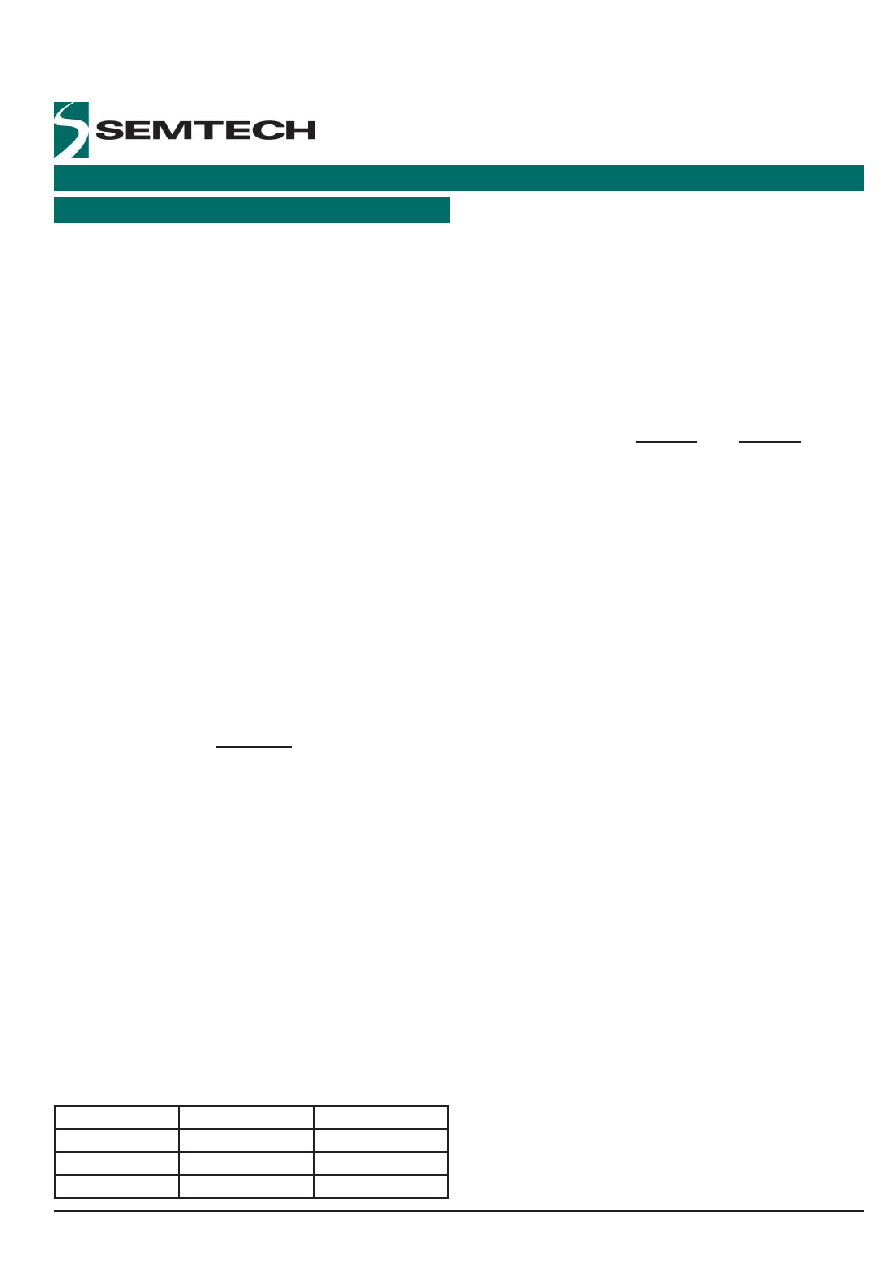- 您現(xiàn)在的位置:買賣IC網 > PDF目錄299883 > SC804IMLTRT (Semtech Corporation) Fully Integrated Lithium-Ion Battery Charger System with Timer PDF資料下載
參數資料
| 型號: | SC804IMLTRT |
| 廠商: | Semtech Corporation |
| 英文描述: | Fully Integrated Lithium-Ion Battery Charger System with Timer |
| 中文描述: | 完全集成的鋰離子電池充電器系統(tǒng)的計時器 |
| 文件頁數: | 21/21頁 |
| 文件大小: | 548K |
| 代理商: | SC804IMLTRT |

9
2007 Semtech Corp.
www.semtech.com
SC804
PRELIMINARY
POWER MANAGEMENT
This adjustment to the fast charge current is obtained
by replacing the xed V
IPRGM reference voltage with the
AFC voltage. (Note that AFC voltages above VIPRGM will
produce I
VOUT exceeding that programmed as per the Fast-
Charge Mode (CC) section.) For any applied AFC voltage,
FCI must not drop below 130mA, and FCI must always
remain at least 80mA greater than PCI.
Termination Current
Once the battery voltage reaches V
CV the SC804 will
transition from constant current mode to constant voltage
mode. The current through the battery will decrease while
the voltage remains constant as the battery becomes fully
charged. When the current falls below the programmed
termination current set by the termination resistor
connected to the ITERM pin, the SC804 will disable
CHRGB. If the timer is enabled the output will continue
to oat-charge in CV mode until the timer expires. If the
timer is disabled, the output will turn off as soon as the
termination current level is reached. The equation to set
the termination current is given by:
ITERM can be programmed to be as high as 300mA or as
low as 50mA, though accuracy is not guaranteed below
100mA. ITERM must be programmed to be less than FCI
for correct operation of the charge cycle.
Monitor Mode
When a charge cycle is complete, the SC804 output turns
off and the device enters monitor mode. If the voltage
of the battery falls below the recharge threshold (VCV
- VReQ), the charger will clear the charge timer and re-
initiate a charge cycle. The maximum current drain of the
battery during monitor mode will be no more than 1
μA
over temperature. The status of the charger output as a
function of the timer and IOUT is tabulated below.
Applications Information
Timer
Iout
Output State
T < Timeout
N/A
On
T > Timeout
N/A
Off
Disabled
< Itermination
Off
V
ITERM_Typ
ITERM =
× 100
R
ITERM
Charge Timer
The timer on the SC804 has two functions: to protect in
the event of a faulty battery and to maximize charging
capacity. The RTIM pin is connected to VCC to select the
internal timer, and to GND to disable the timer.
Connecting a resistor between RTIM and GND will program
the total charge time according to the following equation:
with charge time expressed in hours.
The timer is
programmable over the range of 2 to 6 hours. The internal
timer selection results in a charge time of 3 hours. The
SC804 will automatically turn off the output when the
charge timer times out.
NTC Interface
The NTC pin provides an interface to a battery pack
Negative Temperature Coefcient (NTC) thermistor. The
typical NTC network has a xed resistor from VCC to the
NTC pin, and the battery pack NTC thermistor connected
from the NTC pin to ground. In this conguration, an
increasing battery temperature produces a decreasing
NTC pin voltage, and a decreasing battery temperature
produces an increasing NTC pin voltage.
This conguration is shown in the typical application
schematic on page 1 of this datasheet. When the NTC
voltage from the divider is greater than the high (cold)
threshold or less than the low (hot) threshold, the SC804
suspends the charge cycle by turning off the output,
halting (but not resetting) the charge timer, and indicating
a fault on the FLTB pin. Hysteresis is included for both
high and low NTC thresholds to avoid chatter at the NTC
trip points. When the NTC pin voltage returns to the valid
range, the SC804 automatically resumes the charge cycle.
The charge timer will time-out when the SC804 output on-
time exceeds the timer setting regardless of how long it
has been disabled due to the NTC temperature.
An input voltage between VT
NTCH×V
VCC and the CTO input
voltage V
CTO (VTNTCC×VVCC if CTO is tied to GND) enables
charging. An input voltage outside this range suspends
charging and drives FLTB pin active (low). The internal
NTC thresholds of VT
NTCH and VTNTCC were designed to
3600
Charge time =
×
1
3
(
)
R
RTIM
相關PDF資料 |
PDF描述 |
|---|---|
| SC804 | Fully Integrated Lithium-Ion Battery Charger System with Timer |
| SC805EVB | Miniature Integrated High Current Lithium-Ion Battery Charger |
| SC805IMLTRT | Miniature Integrated High Current Lithium-Ion Battery Charger |
| SC805 | Miniature Integrated High Current Lithium-Ion Battery Charger |
| SC806 | Miniature High Current Lithium-Ion Battery Charger |
相關代理商/技術參數 |
參數描述 |
|---|---|
| SC805 | 制造商:SEMTECH 制造商全稱:Semtech Corporation 功能描述:Miniature Integrated High Current Lithium-Ion Battery Charger |
| SC805A | 制造商:SEMTECH 制造商全稱:Semtech Corporation 功能描述:Miniature Integrated High Current Lithium-Ion Battery Charger |
| SC805A_08 | 制造商:SEMTECH 制造商全稱:Semtech Corporation 功能描述:Miniature Integrated High Current Lithium-Ion Battery Charger |
| SC805AEVB | 制造商:SEMTECH 制造商全稱:Semtech Corporation 功能描述:Miniature Integrated High Current Lithium-Ion Battery Charger |
| SC805AMLTRT | 制造商:Semtech Corporation 功能描述:Current/Constant Voltage Li-Ion/NiCD/NiMH 1000mA 4.2V 10-Pin MLP EP T/R |
發(fā)布緊急采購,3分鐘左右您將得到回復。